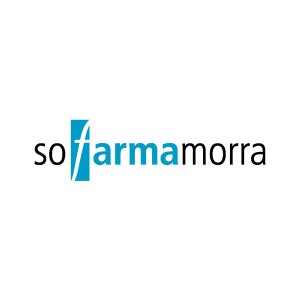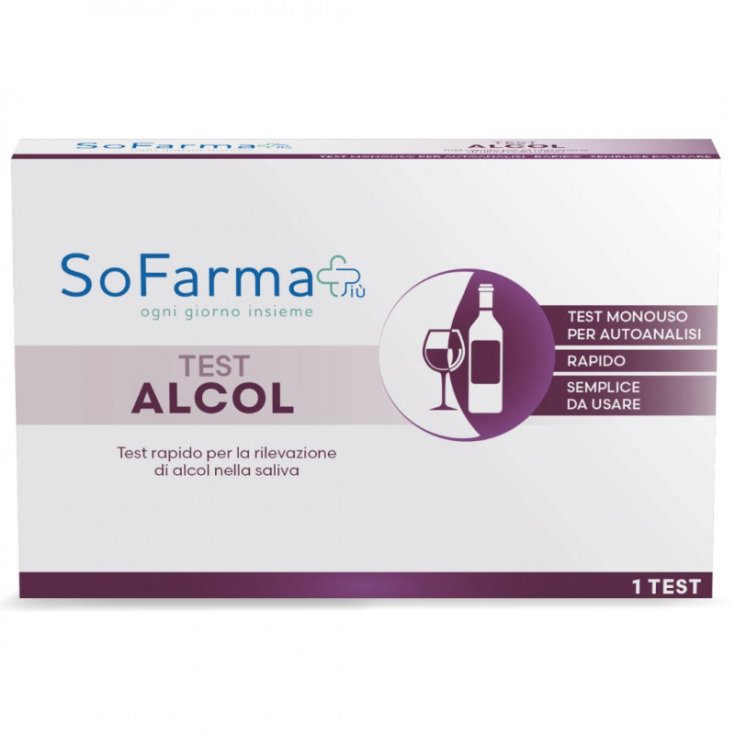SOFARMAPIU' SELFTEST ALCOHOL
2.44€
4.90€

- Brand: SO.FARMA.MORRA SpA
- Product Code: 986872226
- EAN: 8054320670216
- Availability: Out Of Stock
- Purchase 3 items for 2.39€ each
- Purchase 4 items for 2.34€ each
- Purchase 5 items for 2.29€ each
SoFarma
ALCOHOL TEST
Description
Rapid and highly sensitive method to detect the presence of alcohol in saliva and provide an estimate of the relative concentration of alcohol in the blood. The test will in fact react with methyl, ethyl and allyl alcohols.
This test provides only a preliminary result. An additional, more specific chemical method is needed to confirm the clinical result. Clinical consideration and professional medical judgment should also be taken into account for any screening test results, particularly when preliminary screenings are positive.
Instructions for use
Allow the sealed package to reach room temperature (15-30°C) before testing.
Avoid ingesting or coming into contact with anything through the mouth 15 minutes before taking the test (including soft drinks, tobacco products, coffee, breath mints and food).
Collect saliva in the sample collection container.
Open the foil package and take out the device.
Before carrying out the test by applying the saliva sample, it is necessary to observe the reactive swab. If the swab is blue in color it should not be used.
Saturate the reactive swab by immersing it in the saliva collected in the container or by applying the saliva directly to the swab. Usually the time needed to saturate the swab is 6-8 seconds. Start the timer immediately after applying saliva.
Read the result after two minutes. Compare the color of the reaction time with the color chart on the foil pouch to determine the relative blood alcohol level.
Interpretation of results
POSITIVE: the test will produce a change in color of the reactive swab in the presence of alcohol in the saliva. The color will range from a light blue color indicating a relative blood alcohol concentration of 0.02% to a dark blue color denoting a relative blood alcohol concentration of 0.30%.
The test is very sensitive to the presence of alcohol. A lighter shade of blue than that generated in a swab whose relative concentration of alcohol in the blood is 0.02% should be interpreted as positive for the presence of alcohol in the saliva but less than 0.02% alcohol in the blood.
NEGATIVE: when the reactive swab does not show any color change you are faced with a negative result which indicates that alcohol was not detected in the salivary sample.
INVALID: if the reactive swab shows a blue color before applying the saliva sample, do not use the test. It is recommended to contact the seller.
If the swab has a slight color at the edges but the majority of the swab remains colorless, it is advisable to repeat the test with a new device.
Warnings
The test is interpreted visually; Color matching is used to provide an estimate of the relative concentration of alcohol in the blood.
Test materials that have come into contact with saliva should be treated as potentially infectious.
Do not use after the expiry date.
Not intended for medical or diagnostic use.
Fifteen minutes before carrying out the test nothing should be ingested. Failure to do so may produce erroneous results due to possible contamination of the saliva by interfering substances.
Alcohol vapors in the air are sometimes detected by the test dipstick. If the presence of alcohol vapors is suspected, the test should be performed in an area known to be free of them.
Ingesting or using over-the-counter medications and products containing alcohol can g
Rapid and highly sensitive method to detect the presence of alcohol in saliva and provide an estimate of the relative concentration of alcohol in the blood. The test will in fact react with methyl, ethyl and allyl alcohols.
This test provides only a preliminary result. An additional, more specific chemical method is needed to confirm the clinical result. Clinical consideration and professional medical judgment should also be taken into account for any screening test results, particularly when preliminary screenings are positive.
Instructions for use
Allow the sealed package to reach room temperature (15-30°C) before testing.
Avoid ingesting or coming into contact with anything through the mouth 15 minutes before taking the test (including soft drinks, tobacco products, coffee, breath mints and food).
Collect saliva in the sample collection container.
Open the foil package and take out the device.
Before carrying out the test by applying the saliva sample, it is necessary to observe the reactive swab. If the swab is blue in color it should not be used.
Saturate the reactive swab by immersing it in the saliva collected in the container or by applying the saliva directly to the swab. Usually the time needed to saturate the swab is 6-8 seconds. Start the timer immediately after applying saliva.
Read the result after two minutes. Compare the color of the reaction time with the color chart on the foil pouch to determine the relative blood alcohol level.
Interpretation of results
POSITIVE: the test will produce a change in color of the reactive swab in the presence of alcohol in the saliva. The color will range from a light blue color indicating a relative blood alcohol concentration of 0.02% to a dark blue color denoting a relative blood alcohol concentration of 0.30%.
The test is very sensitive to the presence of alcohol. A lighter shade of blue than that generated in a swab whose relative concentration of alcohol in the blood is 0.02% should be interpreted as positive for the presence of alcohol in the saliva but less than 0.02% alcohol in the blood.
NEGATIVE: when the reactive swab does not show any color change you are faced with a negative result which indicates that alcohol was not detected in the salivary sample.
INVALID: if the reactive swab shows a blue color before applying the saliva sample, do not use the test. It is recommended to contact the seller.
If the swab has a slight color at the edges but the majority of the swab remains colorless, it is advisable to repeat the test with a new device.
Warnings
The test is interpreted visually; Color matching is used to provide an estimate of the relative concentration of alcohol in the blood.
Test materials that have come into contact with saliva should be treated as potentially infectious.
Do not use after the expiry date.
Not intended for medical or diagnostic use.
Fifteen minutes before carrying out the test nothing should be ingested. Failure to do so may produce erroneous results due to possible contamination of the saliva by interfering substances.
Alcohol vapors in the air are sometimes detected by the test dipstick. If the presence of alcohol vapors is suspected, the test should be performed in an area known to be free of them.
Ingesting or using over-the-counter medications and products containing alcohol can g

